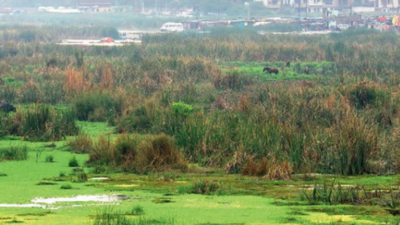In response to increasing concerns over the impact of flooding on communities and ecosystems, a committee comprising environmental experts and policymakers has initiated a crucial endeavor to define river floodplains comprehensively.
Rationale
- Escalating Climate Change Impacts: Extreme weather events, including riverine floods, are becoming more frequent and severe due to climate change.
- Challenges Faced: Riverine floods pose significant challenges to communities in flood-prone areas, necessitating proactive measures for risk mitigation and resilience enhancement.
Objectives
- To finalize a comprehensive definition of river floodplains encompassing geographical, ecological, and hydrological aspects.
- To streamline flood management strategies, improve zoning regulations, and enhance disaster preparedness efforts.
Collaborative Approach
- Diverse Stakeholders: Environmental scientists, policymakers, community leaders, and other relevant stakeholders.
- Standardized Definition: Aims to establish a standardized definition for river floodplains.
Impacts and Benefits
- Effective Land-use Planning: Facilitates more effective land-use planning and development policies.
- Minimized Exposure to Flood Hazards: Ensures that vulnerable areas are appropriately managed to minimize exposure to flood hazards.
- Conservation of Natural Habitats: Promotes the conservation of natural habitats and biodiversity associated with river ecosystems.
Commitment to Rigorous Approach
- Research: Rigorous research and data-driven analyses.
- Stakeholder Consultations: Engaging stakeholders for inputs and feedback.
- Scientific Insights: Leveraging scientific insights to inform the definition of river floodplains.
Conclusion
As the April 18 deadline approaches, the committee remains committed to delivering a robust framework that will guide future flood management practices and safeguard communities against the escalating threat of riverine floods.
Multiple Choice Questions (MCQs) with Answers:
- What is the primary objective of the committee mentioned in the passage?
- A) To address environmental pollution
- B) To define river floodplains comprehensively
- C) To promote urbanization in flood-prone areas
- D) To enhance agricultural practices along rivers
- What is driving the committee’s initiative?
- A) Decreasing concerns over flooding
- B) Declining frequency of extreme weather events
- C) Escalating climate change impacts
- D) Increasing availability of flood insurance
- Who are the stakeholders involved in the committee’s efforts?
- A) Only environmental scientists
- B) Only policymakers
- C) A range of stakeholders including environmental scientists, policymakers, and community leaders
- D) Only community leaders
- What benefits are associated with a clear definition of river floodplains?
- A) Increased exposure to flood hazards
- B) Promotion of urbanization in flood-prone areas
- C) Conservation of natural habitats and biodiversity
- D) Decline in disaster preparedness efforts
- How does the committee plan to inform its definition of river floodplains?
- A) Through guesswork
- B) By ignoring scientific insights
- C) Through rigorous research, stakeholder consultations, and data-driven analyses
- D) By relying solely on anecdotal evidence
